
BLOG
I’ve got a creative problem for you, Liz Gilbert, but I am almost too afraid to ask for help
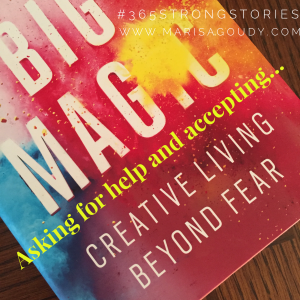 Elizabeth Gilbert, the magical creature behind Big Magic and Eat, Pray, Love is inviting us all to come to her with our creative aches and pains. (See her Facebook post here.)
As we prepare for house guests to arrive - scrubbing just enough to make the place look decent before our families destroy the place again - I’ve been writing and rewriting my 100-word submission in my head.
Elizabeth Gilbert, the magical creature behind Big Magic and Eat, Pray, Love is inviting us all to come to her with our creative aches and pains. (See her Facebook post here.)
As we prepare for house guests to arrive - scrubbing just enough to make the place look decent before our families destroy the place again - I’ve been writing and rewriting my 100-word submission in my head.
You can read what I'm sending below, but first, an admission: I’m afraid to admit I have a creative problem.
So much of creating and manifesting a livelihood and leading a life seems like a head game. “Your thoughts create your reality” and “Where the mind goes, the energy flows” and all that… If I spend a day thinking up all the ways I’m a pathetic creative lost in the woods who needs a brilliant best selling writer to save me am I giving up whatever creative power I have? Thing is, being afraid to ask for help, of course is by far more isolating and disempowering. This crafting a business and doing the creative work is hard enough. Let’s all hold hands and ask for guidance and healing when it’s offered.
My Magic Lessons Submission
As a “creative entrepreneur,” I try to make the writing I love to do serve the work I have to do as a writing coach.
I launched my #365StrongStories project to give myself a creative outlet and to show potential clients that it’s possible to “create content” (Ie. tell stories) every day. Most of the time, however, I seem to end up in a no man’s land trapped between the stories I want to write and the stories that I hope will help me build a business.
Entrepreneurship is a necessary creative act, but it threatens my true creativity.
Would a #365project give you what you need in 2016?
Why I kept one #365project promise, broke another, and will make a new one in 2016
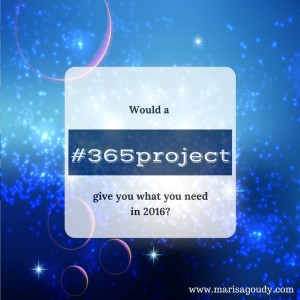 When you sign yourself up to make something every day for an entire year, you’re making a fabulous commitment to your creativity.
When you sign yourself up to make something every day for an entire year, you’re making a fabulous commitment to your creativity.
And when you decide to post about it every day on social media, you’re stepping up and saying “I’m ready to be seen” in a big way.
As both a #365project success story and a #365project drop out, I know plenty about what it takes to make it work and why it might not.
And I know what makes a project fulfilling and worthwhile… all year long.
First, ask yourself what kind of content you would want to share every day
Brené Brown makes it easy to decide what subjects to post about and talk about:
“I share what is vulnerable, not what is intimate.”
And how does our Daring Greatly/ Rising Strong sage recommend you make the distinction between the two?
Brené makes sure that she has fully explored everything before she brings it to the public arena. Her ability to heal and remain “wholehearted” does not depend on how her audience reacts to what she shares.
When I heard her describe this during a recent interview, it hit home because I’d learned this distinction myself - the hard way.
I’m deeply grateful for one successful #365project and one abandoned attempt the following year. They taught me what it really means to share my story, create media, and be seen. And they taught me how to distinguish between intimate and vulnerable.
A #365project helps you find meaning in your own story
In 2014, I participated in the #365feministselfie project.
I cataloged the last month of pregnancy, the wonder of new motherhood, and lots of mundane moments throughout that year. Some of the Instagram shots were raw, some were posed pics to help bolster a bleary-eyed mama’s self esteem. All of them were me.
This daily practice helped me cope with the isolation of being a work-at-home mom with an infant in the midst of the Polar Vortex winter. It was my chance to discover my own narrative thread when it was all too easy to lose myself.
I didn’t have the free hands to write, but I could snap a pic and use my thumbs to draft a quick caption that gave the moment some context in my bigger story.
A #365project that didn’t work
Giddy with the triumph of devoting a year to someone else’s project, I was excited to start my own project in 2015.
Boldly, I called it #365SovereignReality. The goal was to publicly explore my evolving “concept” that made so much sense inside my own head, but hadn’t made it into easy-to-tell story form.
It didn’t last for lots of reasons. The pressure to make an important discovery about my life’s work every day and post it online was too daunting. It took almost no creative energy to snap and post a selfie. My ill-defined sovereignty project demanded more creative energy than I had to give.
Intimate moments need to stay that way
My own pet project failed for another key reason - my kids.
Now that I had permission to take the camera off myself, it seemed logical to turn it on my constant companions. My little muses had been in plenty of the selfies with me, so it didn’t seem like a problem.
Truthfully, I’d always ignored the little voice that said “don’t start creating your kids’ digital footprint without their consent.” But somehow, when I was always in the frame with them, I could give it a pass. I told myself that my protective maternal gaze warded off predators and voyeurs.
But now that I was casting them in leading roles in my #365SovereignReality, it didn’t seem right. Without their mama in the frame to keep them safe, it didn’t seem authentic - it seemed like I was exposing them to stranger danger.
A new #365project that hits all the right notes
So, what are the ingredients of a sustainable #365project?
- It has a set form. You don’t have to expend extra creative energy figuring out the focus.
- It’s related to your professional or creative work.
- It’s about visibility, not ego.
- It’s a practice that helps you grow - not just another “should” or obligation.
Introducing #365StrongStories
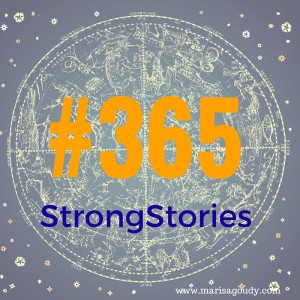 Every day in 2016 I am going to write a story.
Every day in 2016 I am going to write a story.
It will be less than 200 words. Sometimes, it may not look like much more than a metaphor. There will be days when I’m sharing someone else’s story and using a quote. Each story will be accompanied by a picture, so you'll find it on Instagram and Facebook and all the usual social spots.
It feels a little crazy to sign myself up for something so ambitious. After all, taking a picture is easy compared to promising to write an actual story every day. But I’m dedicating my professional life to helping people tell stories that matter… and I need to walk the talk about how it really can be easy.
My 2016 #365project why…
- I am a storyteller, but I want to get better
- I want to be a more concise, efficient writer
- I’ve been in retreat for a while and it’s time to be seen online again
- #365StrongStories is aligned with my work. In a week or two, I am launching an offer called 5 Strong Stories that helps emerging thought leaders write content that connects.
Would a #365project give you what you need in 2016?
Saundra Goldman, who created a brilliant community around her #continuouspractice project posted her reflections on 2015 and her plans for 2016. Check out her post for ideas for creating your own project and why it's totally valid to make a much shorter commitment than 365 days.
And I'm grateful to Saundra for another idea - who will you dedicate your practice to?
I am dedicating #365StrongStories to you, my dear reader. I am going to tell the stories that I must tell, but only because I think they are the stories that you must hear.
Hold on there, summer friend - is that adventure really worth blogging about?
Sovereign Standard, Issue 24 It's one of those working-vacation weeks. You know the type -- you hope to be at least semi-productive and still have a good time (all the while ensuring that your own deadlines don't kill anyone else's relaxation buzz).
It's one of those working-vacation weeks. You know the type -- you hope to be at least semi-productive and still have a good time (all the while ensuring that your own deadlines don't kill anyone else's relaxation buzz).
I think I'm managing this tightrope act as the girls and I visit the folks back at home on Cape Cod.
Juggling and magic shows, long days at the beach with multiple sunscreen applications, and mom trying to get some client stuff done after everyone is asleep… You know, the usual.
I started to write a post about why the internet is like sharing news with a big, noisy family.
There was an outside possibility that it was going to be the best thing I’d ever written. Honestly though, the Red Sox have a better shot at the pennant than I have at making that post worth more than a “that’s nice” comment as you, dear reader, return to your “if only I wasn’t working right now” daydreams.
But now, I'm typing this at the breakfast table. In case you didn't know - laptops and eggs and that beautiful noisy family on a perfect Cape Cod August morning don't mix.
The few paragraphs I had written about how the digital world is like endless summer have about as much life in them as a deflated beach ball. Because I love you, I am going to spare you all that.
I could slam the laptop shut and climb back into a bed full of sand rather than hit publish (the joys of sharing a sleeping surface with an 18 month old who naps right after the first beach trip of the day).
Instead, I am writing about what’s not really worth saying.
Do not pour another precious hour into a blah, blah, blah blog post that you can’t even be bothered to care about until you pause a moment.
Is it time to step away from the keyboard?
Ask yourself: Is it worth writing anything at all?
The answer is NO if you don’t have a steady commitment to your newsletter and blog reader.
Don’t force yourself to meet some personal, arbitrary writing deadline if you don’t really have anything to say. You run the risk of losing them forever because you couldn’t bring your “A” game.
The answer is YES if you have a palpable enough connection to your readership that they’ll care about your well-deserved vacation or your writer’s block or the distraction that is keeping you from doing the “real” writing.
Just be cautious here - the same “make the reader the hero” rules apply here. Your hard working readers want the best for you, but what’s in it for them as you share your bliss and your struggles?
The ultimate test: do you have a Call to Action?
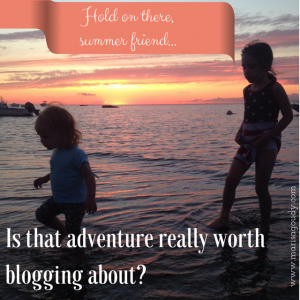 In my case, I am writing about not writing because I know that you need some guidance about what not to say as much as you’d like help with deciding what you want to say.
In my case, I am writing about not writing because I know that you need some guidance about what not to say as much as you’d like help with deciding what you want to say.
The clincher question as you decide whether or not to spend another summertime minute on a blog post: do you have a call to action?
A call to action is that thing you ask your reader to do at the end of each post (sign up for the list, listen to this podcast episode, attend my next event, etc.). It’s the raison d’etre for any particular post on your business blog.
When you know what your reader to do, it’s pretty easy to write them in that direction.
If you’re too busy thinking about whether the kids are getting a burn or whether the next drink will have an umbrella in it to think about what your reader should do when they’re done reading, it might be a good idea to skip posting an article this week.
My call to action for you
Trust the present moment. Observe the needs of your business and the tides of your life.
Write when you’re called to.
Step away from the laptop when you can.
Bring your best to your family and your readers and give each group the time they really need.
How to Write for the Skimming Reader (and actually be ok with it)
Sovereign Standard, Issue 17 If you’re skimming this post, you’re “doing the internet” right. You’re granting this piece just enough attention to glean useful information. And, if it would be of interest to the people you wish to engage, you’ll share it with a brief comment that shows you’re paying attention to important things.
If you’re skimming this post, you’re “doing the internet” right. You’re granting this piece just enough attention to glean useful information. And, if it would be of interest to the people you wish to engage, you’ll share it with a brief comment that shows you’re paying attention to important things.
If, as a writer, I’ve done the internet right, you find it easy to breeze through these 1600 words. You get what you need, How to Write for the Skimming Reader (and actually be ok with it), and move on.
Headers help you navigate. Lists help to break the main ideas into bite sized portions. Bold passages show you when to pay attention.
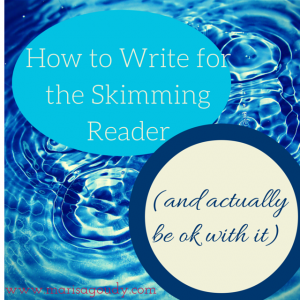 Yes, there are technical points to master - they matter (find more steps on doing that below). But you know there's more to writing a post that people care about than "just make it skimmable.”
Yes, there are technical points to master - they matter (find more steps on doing that below). But you know there's more to writing a post that people care about than "just make it skimmable.”
In order for something to read quickly and easily, you as the writer have to put in a heck of a lot of time and effort.
Does that sort of make you want to cry?
The internet really has changed how we read & think
You want to be available to your potential clients, customers, and readers, so you write content and post it online.
Even if their attention is scattered, it’s something, right?
The goal is to give people just enough in a blog post to engage their curiosity. Once you've intrigued them, they’ll invest their attention in a longer piece of your writing (a book either on their tablets or in print). When blogging is part of your content marketing strategy, you’re hoping that readers who got free content will soon spend money on your product or service.
You’re hoping that your readers have what Tufts University's Maryanne Wolf calls a “bi-literate brain.” They'll switch from a quick skim to an in-depth relationship with your work.
Professor Wolf researches the effects of this online skimming on our ability to read like we're "supposed to." Listen to this Note to Self podcast for assurance that you’re not alone if you feel like your brain works differently these days. Many are finding it hard to jump from speedy info consumption to contemplative, focused reading. (I'm just grateful I had to read Ulysses before the Web rewired my mind!)
In a Washington Post article, Wolf says:
We can’t turn back. We should be simultaneously reading to children from books, giving them print, helping them learn this slower mode, and at the same time steadily increasing their immersion into the technological, digital age. It’s both. We have to ask the question: What do we want to preserve?
Personally, I want to preserve that alchemical process of turning thought into written words that inspire a reader and change the world - even if many readers are just skipping through, looking for the quick news they can use.
How do you write when your reader's brain has been altered?
These sources don’t explore what it means to write with and for these new brains. As Note to Self says about what they found in the course of this episode:
It's another example of a phenomenon we see over and over again: If you feel like a device or any technology has messed with you, you might be onto something... way before any researcher can prove it.
The internet has messed with the way your readers engage with your content - now what?
[tweetthis]The internet has messed with the way your readers engage with your content - now what?[/tweetthis]
As a writer who lavishes her writing talents on screen-only material, this is how I cope with the reader who’s just skimming through:
- Accept that blogging is a bit like Zen sand art
- Write “good enough to be proud of” blog posts that meet my audience's expectations of an online reading experience
Blogging: an object lesson in impermanence
Blogging is an ephemeral art - and I believe it can and even should be an art, not just a perfunctory advertising technique.
Writing for the internet is a lesson in accepting the impermanent nature of life. Even posts that go viral get shunted off the front page eventually.
I think we can go further to say that blogging is also a spiritual practice. After all, blogging teaches you how to resist attachment. You simply cannot expect specific outcomes and end up feeling successful.
A blog is part of the business long game. There’s no guarantee that any post will bring in a dime. If there is an ROI, it’ll be cumulative and hard to trace to this one bit of writing. Instead, each post builds a relationship and takes a potential client that much closer to trusting you with their investment.
Most of the gifts of blogging come through the practice…
- The practice of writing each post gives you a chance to explore ideas as they occur to you. You can spend a few hours thinking deeply about how to communicate your thoughts into comprehensible messages. That sort of deep thought helps you maintain your bi-literate brain.
- The practice of maintaining a blog and writing over time gives you the chance to examine how your visions has grown and changed. You are able understand the relationships between your ideas and develop them into something more lasting like a book or a program.
A blog post is impermanent and they're just skimming it anyway - does it have to be perfect?
One of the first lessons in living without attachment I ever learned: let go of perfection. (As a writer who gets paid for typo-free prose, this was a hard one for me.)
Perfectionism really does equal paralysis. It also is responsible for business writing that never gets done and countless client relationships that never had a chance to get started.
So, “chuck perfect” as Karen Brody says.
Instead, focus on consistently creating material that is just good enough to stake your professional reputation on. Not every post needs to be a magnum opus. (Though keep in mind: you just never know when a particular passage is going to be your all important first impression.)
5 Features of a Good Enough to Be Proud of Blog Post
- Focused. The post is designed to convey one single, elegant idea. Take the pressure off yourself and the post itself by allowing it to perform a single simple task. Chances are, you can always get three posts out a single “ah ha!” moment. Dare to be brief or to go deep with one concept.
- Well-written: The post is as close to typo free as you can get after three read throughs. People can look past a few errors, but consistent oopses will erode your credibility. If you’re killing yourself to catch the missed words and you stress over every potential there/their/they’re humiliation, retain me as your writing coach and editor.
- Clear & organized: If your reader wants to skim, help them! Cut adjectives. Use small words and short sentences.Use headers that a clear rather than clever so your reader skip around as they please. Break ideas down into lists even if that offends your sensibilities as a “real” writer.
- Story-driven: The post is framed by a story or uses storytelling to convey main ideas. You use stories to give readers a taste of who you are, but also to engage yourself in the process. Stories breathe life into information. Don't lose yourself (and the reader) in your autobiography, but do allow your personality to shine through.
- Relevant: If the post is going to appear on your business blog, it has to relate to a product or service you offer or speak directly to the questions and concerns of your ideal client. Wrote a beautiful essay about seeing an eagle in flight or want to share your opinions on your favorite Netflix drama? That’s nice. Don’t blog it here. What you publish serves the mission of your business - to solve the problems of your customers and clients. If it doesn't, put it on your personal social media profile or submit it as a guest post someplace else.
But does it still hurt that you’re getting skimmed over?
No one has ever accused me of being particularly “zen” - at least not with a straight face. I strive to practice this non-attachment thing and ignore my stats and trust good content to make its own way (with some strategic social sharing, of course). Sometimes, however, it seems like we’re in a permanent state of imbalance - pouring all this exacting energy into writing something that people skim and consume rather than read.
People are turning to podcasting and YouTube for this very reason. I understand the attraction, but I still believe that it’s worth writing for your business - especially when you’re armed with the right mindset and understand that the rewards of writing may emerge far in the future.
Why it’s important to keep writing - and writing well - for the online readers
- You’re smart and literate. There’s a great chance that your ideal clients and customers are too, If you like to write, the person who thinks you’re perfect probably likes to read. That’s a good enough place to start - even if they’re "just" skimming your blog.
- Writing helps you think. It helps you discover new ideas and develop them from zygotic in the shower thoughts into big, beautiful visions that change lives.
- Though the human brain was not designed to read and write, we’ve been doing it for over 5000 years. I’m going to side with tradition on this one and conclude that we won’t stop reading in just one or two technology drenched generations
I’d love to help you contribute to the perpetuation of the English language. Oh, and help you communicate your ideas to your audience too. Here’s how I can help you as your writing coach.
How a 365 photo project makes you a better writer
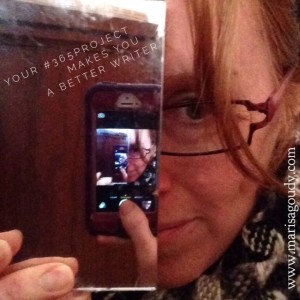 The more pictures you take, the better writer you’ll become.
Yeah, right, you say. Writing makes you a better writer, not messing around with photo filters and getting lost in the endless Instagram dinner plate captures.
The more pictures you take, the better writer you’ll become.
Yeah, right, you say. Writing makes you a better writer, not messing around with photo filters and getting lost in the endless Instagram dinner plate captures.
From more than a year’s experience of daily shooting and posting, I can promise you that the process really does take you closer to your writing goals - especially when it comes to writing for the digital universe.
Five Things Writers Gain From a 365 Photo Project
- Discipline: In order to become the sort of writer you want to be you need to practice. Once you establish that you can do something every day, like taking a picture and sharing it to social media, you prove to yourself that you can do anything - including writing every day.
- Visibility: Being a writer isn’t just about writing - at least not if you want people to read your stuff. Daily images boost your overall online profile, even if they aren’t each perfectly aligned with the work you ultimately wish to promote. In 2014, I participated in the #365feministselfie project. Did all those pictures of my kids and me tell you about what I can do as an author and a writing coach? No, but they told you a lot about me and that’s what will really help potential clients pick me and future readers get excited about my books.
- Brevity: Photo projects aren’t just about the visual. The picture is worth a thousand words, of course, but the words you use to introduce and contextualize the image still matter. One of the most important skills for online writing is the ability to be engaging and yet concise. When you're limited by what your thumbs can comfortably tap into your phone and you know shouldn’t say more than your distracted viewers will take in, you learn the skill of the the short and sweet. (Full disclosure: I have trouble with this and often write wicked long captions because they're still quicker than a blog post!)
- Outliers: To paraphrase Alice in Wonderland, you’ve surely imagined six visionary creative projects before breakfast, but they’re all outlier ideas you have to dismiss. They're “distractions” from your “real” project. What if your daily photo snap could be a five minute journey into those excess ideas? Your satisfying the muse and you're cataloging those ideas for later.
 Play: Though defined as “pleasurable and apparently purposeless activity," we know that play is so much more than that. It is what keeps us vibrant, engaged, and flexible on every level. You’re not a photographer. Your pictures will only occasionally be brilliant. Allow that and find delight as you mess around with something you don’t have to be good at.
Play: Though defined as “pleasurable and apparently purposeless activity," we know that play is so much more than that. It is what keeps us vibrant, engaged, and flexible on every level. You’re not a photographer. Your pictures will only occasionally be brilliant. Allow that and find delight as you mess around with something you don’t have to be good at.
Is there a downside to devoting a few minutes a day to a 365 project?
I'm an unabashed #365project devotee and I can't imagine I'll ever quit, the practice has so many benefits. If I stretch, I can find one downside though...
I take pictures to illustrate the story going on in my head, whether its actually from a piece of fiction I’m working on or part of my professional or personal story.
My images likely suffer since I’m grabbing the phone to snap a pic to explain a work in progress rather than seeing the magic of the moment or object itself. Taken out of context, the picture may not be all that meaningful to your audience (and you’re practicing brevity in those captions and don’t want to write a novel about each pic).
But that is the joy of a 365 project - you always have a chance to make a distinctive piece of art tomorrow! And again, simply showing up every day and creating a 365 piece puzzle has a magic of its own for your visibility. Every puzzle piece isn't meant to stand alone.
But really, should you just do a #Write365 project?
Yes, you could always do a 365 writing project… It would help you build discipline and visibility and maybe brevity, but there’s a great chance you’ll lose out on the play and the chance to explore those outlier ideas.
My project for the year is called #365SovereignReality. Follow me on Instagram or Google+ for a window into my 2015 as I discover what it means to “become sovereign in my own reality.”



